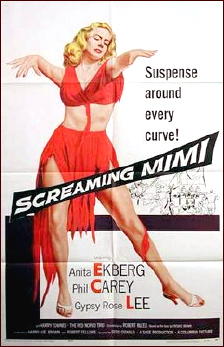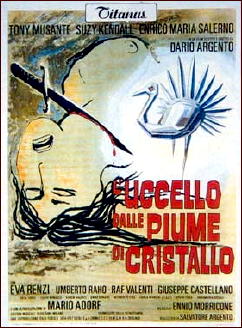Search Results for 'Fredric Brown'
Did you find what you wanted ?
Mon 20 Jan 2014
Posted by Steve under
Reviews[5] Comments
REVIEWED BY DAN STUMPF:
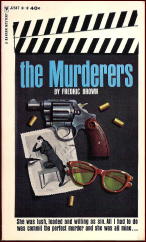
FREDRIC BROWN – The Murderers. Dutton, hardcover, 1961. Bantam J2587, paperback, 1963.
— Knock Three-One-Two. Dutton, hardcover, 1959.Bantam A2135, paperback, 1960.
I’ve had a couple Fredric Brown’s on my shelf since Hubin-knows-when, but when I glanced at the covers the other day I couldn’t for the life of me remember reading them.
The Murderers is pleasantly amoral right up to the cop-out ending. Two unemployed actors find their careers stymied by different adverse circumstances and decide to solve their problems by swapping murders. Everything goes along smoothy and even enjoyably until … well, as I aid, the ending’s a disappointment, but it doesn’t come until late in the book, which is mostly slick and much fun.
Knock Three-One-Two is just as contrived and just as enjoyable. Ray Fleck, the hero of the piece is a two-bit, two-timing, half-smart chiseler and gambling addict (though the term was unknown back then) looking to score the Big One that will wipe out his debts and get him back in the Game.
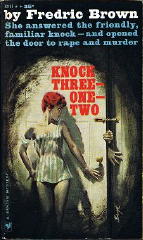
Knock is the account of his night-long unlucky odyssey to that elusive home, set against the backdrop of a city plagued by an elusive serial killer.
It’s something to the credit of Brown’s writing that the extraordinary contrivances of this thing don’t seem all that apparent until you set it down and start thinking about it.
SPOILER ALERT — PLOT DETAILS AHEAD!
Every bet that Ray makes he loses, every ploy he tries backfires, every turn he takes is wrong one, right up to the end, when he gets the chance to score several thousand dollars of insurance money — by steering the Serial Killer to his wife.
END OF WARNING.
The resolution is unsurprising, but Brown delivers the package neatly enough that it’s a pleasure reading it.
Tue 3 Jul 2012
IT’S ABOUT CRIME, by Marvin Lachman
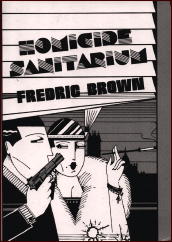
In a very imaginative job of publishing, Dennis McMillan Publications has collected many of the early pulp mysteries of Fredric Brown and published five paperback collections, at $5.95 each: Before She Kills, The Freak Show Murders, Homicide Sanitarium, Pardon My Ghoulish Laughter, and 30 Corpses Every Thursday, which contain introductions by William F. Nolan, Richard Lupoff, Bill Pronzini, Donald Westlake, and William Campbell Gault, respectively.
Each introduction limns a different aspect of Brown’s life and work. No, these stories aren’t quite as well written as Brown’s later novels. After all, he was a more experienced writer when he penned The Fabulous Clipjoint and The Lenient Beast.
Still, they’re just as readable, and what a joy to be able to read material from forgotten pulps of the early 1940’s like Thrilling Detective, G-Man Detective, Clues, Popular Detective, Ten Detective Aces, Strange Detective Mysteries, and Phantom Detective.
Homicide Sanitarium even contains Brown’s very first story, “The Moon for a Nickel,” from the March 1938 Detective Story Magazine.
— Reprinted from The MYSTERY FANcier,
Vol. 11, No. 1, Winter 1989.
Editorial Comments: In all Dennis McMillan did something like 18 collections of Fredric Brown’s shorter work, including poetry and some non-fiction, most of them appearing after this review was published.
This is the first of several reviews of anthologies and short story collections that Marv Lachman wrote for this same issue of The MYSTERY FANcier. Look for most of them to be posted here over the next few weeks.
Thu 18 Aug 2011
REVIEWED BY DAN STUMPF:
THE SCREAMING MIMI. Columbia, 1958. Anita Ekberg, Philip Carey, Gypsy Rose Lee, Harry Townes, Linda Cherney, Romney Brent, Red Norvo (and Trio). Based on the novel by Fredric Brown. Director: Gerd Oswald.
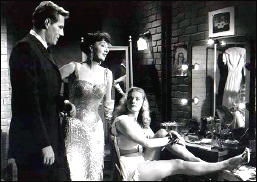
The Screaming Mimi offers some kicking-and-kinky direction from Gerd Oswald, a cult director in the Jim Jones tradition, which is to say he showed a lot of potential in low-budget westerns and thrillers, and managed one classic, A Kiss Before Dying (1956) before drinking the kool-ade of network television.
Mimi belongs to his Promising period, with a pleasingly straightforward (for the 50s) approach to homosexuality, bondage, obsession and amour fou, but it’s undone by a screenplay that seems way too limp for a movie about serial killings.
There’s never a sense of momentum here, no feeling of progressing towards some resolution. Instead, events just seem to come along and happen in no particular order, then head off in any direction whatever, just sort of strutting and fretting across the screen till their allotted hour-or-so is over at last. A pity, because there are glimmers here and there of what could have been a perverse classic.
THE BIRD WITH THE CRYSTAL PLUMAGE. Central Cinema Company, Italy, 1970. Original title: L’uccello dalle piume di cristallo. Tony Musante. Suzy Kendall, Enrico Maria Salerno, Eva Renzi, Umberto Raho, Raf Valenti. Based on the novel The Screaming Mimi by Fredric Brown (uncredited). Director: Dario Argento.
The Bird with the Crystal Plumage (Italy, 1970) on the other hand, is a certified wowser. The directorial debut of Dario Argento, who became something of a Name in Horror films, this is a garish, fast-moving, humorous movie about serial slashing, stalking, knifing and general mayhem set against colorful locations, played and/or dubbed by a cast a cut (sorry!) above the usual run of Italian imports.
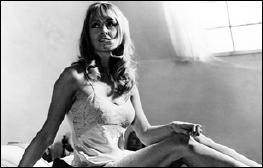
Fredric Brown got no screen credit for this film, and for years critics who knew nothing about Pulp averred that it was based on an Edgar Wallace story, but I defy anyone out there to show me an Edgar Wallace book with this plot. In fact, I’ll wrestle anyone in the crowd who thinks he can do it. No takers? I thought not.
Anyway, getting back to the story, this follows Brown’s novel pretty closely, right down to the minor characters and bits of by-play. Argento tossed away the thematic framework of Brown’s novel, and he turned the hard-drinking loner of the book into a young married couple, but that’s a fate that befell many of us in the 70s.
The fact is, this is a fairly faithful translation of The Screaming Mimi into film, and if not all it could have been. (The real meaning of the book isn’t revealed until the last page, and it’s truly harrowing.) It’s at least a fun ride.
Sun 14 Aug 2011
Posted by Steve under
Reviews[13] Comments
REVIEWED BY DAN STUMPF:
FREDRIC BROWN – Night of the Jabberwock. E. P. Dutton, hardcover, 1950. Paperback editions include: Bantam #990, April 1952; Morrow-Quill, 1984. British edition: T. V. Boardman, hc, 1951.

Based on two pulp stories: “The Gibbering Night†(Detective Tales, July 1944) and “The Jabberwock Murders†(Thrilling Mystery, Summer 1944).
I recently took a couple days to re-read the greatest book ever written in the English Language, Fredric Brown’s Night of the Jabberwock, which can’t be beat in terms of structure, action, characterization, or much of anything else for that matter.
The tale is of a night in the life of “Doc” Stoeger, middle-aged editor of a small-town weekly newspaper — the kind of publication now put out by a syndicate if it exists at all, in a town that nowadays has become a suburb or a fiefdom of Wal-Mart.
But back in 1950, the small town and its paper were vibrant, charming bits of Americana, just like Brown’s novel, which starts off with Doc putting his sleepy little paper to bed, sadly looking at the front-page news of a church rummage sale and wishing he could somehow just once break a major story.
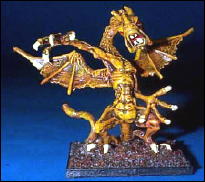
What follows is a night of wonderland-style adventures and reverses, as a mysterious visitor initiates him into The Vorpal Blades, a select club devoted to serious study of Lewis Carroll, major stories fly into his lap like scattered playing cards, he becomes a small-town hero, a hunted fugitive, kidnap victim and kidnapper himself.
All this is tossed off with the deceptively easy style only Fredric Brown could do so well. And speaking of Tossed Off, someone should go through this book with a calculator and see how much Doc drinks during the course of an evening; every chapter is punctuated by him having two or three drinks, then sobering up, then drinking again, drinking more, sobering… at some point it gets a bit ridiculous, but somehow the humor only adds to the charm of this witty and elegant adventure through a looking-glass.

By the way, this sent me back to re-reading Alice in Wonderland and Through the Looking Glass, books I hadn’t seen since childhood. And I have to say their charm was sadly lost on me.
There’s some excellent doggerel there, perhaps up to the level of Edward Lear, but in their hurry to get from one scene to another, the stories never seem to get anyplace; colorful characters never do anything interesting, and conversations all consist merely of people contradicting Alice.
Or am I missing something?
Sat 31 Oct 2009
REVIEWED BY GEOFF BRADLEY:

FREDRIC BROWN – Night of the Jabberwock. E. P. Dutton, hardcover, 1950. Paperback editions include: Bantam #990, April 1952; Morrow-Quill, 1984. British edition: T. V. Boardman, hc, 1951.
Based on two pulp stories: “The Gibbering Night” (Detective Tales, July 1944) and “The Jabberwock Murders” (Thrilling Mystery, Summer 1944).
After hearing several people tell me about this book, I just had to read it. I went up to the loft and searched but to no avail. Fortunately a couple of days later, when I was looking for something else, I stumbled across my copy.

Doc Stoeger, the narrator, is the proprietor/editor of a small town newspaper and a huge fan of the work of Lewis Carroll. After putting the paper to bed and getting home for the evening, he faces a night of catastrophic events, including a mysterious bank robbery, an escaped lunatic, a midnight gathering of the Vorpal Blades in a haunted house, and more.
Most of them are unconnected, but after a murder for which he has been framed, Doc is fighting for his life and an explanation that will make sense of what has gone on.
That the explanation makes as much sense as it does is a tribute to the plotting abilities of Fredric Brown, who has weaved a tangled web of intrigue. This madcap, humorous affair is a pleasurable romp with a satisfying ending, and I enjoyed the reading of it.
Brown is an author that I am underexposed to, having previously only read Madball, which was only so-so, and The Fabulous Clipjoint, the first in the Ed and Am Hunter series, which I somehow didn’t take to.
Editorial Comment: Happy Halloween, everyone!
Tue 16 Aug 2022
Posted by Steve under
Reviews[8] Comments
REVIEWED BY TONY BAER:
WILSON TUCKER – The Chinese Doll. Charles Horne #1. Rinehart, hardcover, 1946. Detective Book Club, hardcover, 3-in-1 edition, May 1947. Dell #343, mapback edition, 1949.
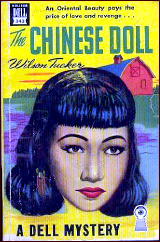
Charles Horne is a mediocre PI in a one horse town in Illinois. Just sitting around.
Then a snazzy large dude named Evans bursts in, hands him $500 cash and says it’s for bail because he’s about to be arrested. He immediately bursts out of the office, getting flattened by a cute Chinese girl in a supercharged Studebaker who doesn’t bother to touch her brakes.
The car’s later found trashed on the side of the road. It belongs to Evans, the guy that just got run over.
Later that night the same Chinese chick picks our detective up in a brand new supercharged Studebaker and takes him to a secret casino hidden in a barn in the countryside run by the mob.
Departing the casino that eve, he sees the Chinese doll skating on the frozen pond. It’s the last he sees of her alive as she shows up in the morning morgue, drowned. In tap water.
It turns out the doll and Evans were in love, she his mistress, she with child, he remained with wife. So kablammo.
But things are not always what they seem, as the mob was pulling all the strings. And wrapping up with bow and string, they drowned her, the Chinese doll.
Horne is bound and determined to earn the $500 from his dead client and get to the bottom of things. He does, after a time, and in the nick of time too.
Horne is not particularly hard or tough or smart or brave. He starts shaking when in danger. He makes witless decisions putting himself and his clients in harm’s way. He lets the bad guys push him around. Sometimes you wish Mike Hammer would show up and slap the meshuggenah out of him.
And worst of all he writes every single thing to his wife by letter. Every confidence. Every move. Every thought. The entire book is in fact a book of letters from Mr. to Mrs. Horne, during the pendency of their trial separation.
I thought I was going to complain about this affectation. But I can’t. Because this affectation is the plot device upon which the entire novel turns.
It’s a bit like the Fredric Brown’s surprise in his short story “Don’t Look Behind You†in that the medium is vital to the message.
It’s a good detective novel. It kept my attention and the ending was unique and surprising.
It’s also nice to know that the device could only be used once because frankly I detest books of letters.
NOTE: Previously reviewed on this blog by William Deeck here.
Tue 23 Feb 2021
Posted by Steve under
Reviews[16] Comments
REVIEWED BY DAN STUMPF:
â— HENRY KANE. My Darlin’ Evangeline. Dell First Edition B198, paperback original; 1st printing, 1961. Revised and reprinted as The Perfect Crime (Belmont, paperback, 1967). TV Adaptation: As “An Out for Oscar,” The Alfred Hitchcock Hour, 05 Apr 1963 (screenplay by David Goodis).
â— HENRY KANE. Death on the Double. PI Peter Chambers #13. Avon #761, paperback original; 1st printing, 1957. Signet D2644, paperback, 1965.
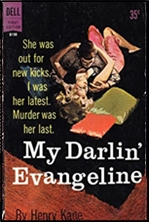
A week or so ago I looked through my vast, well-organized (HAH!) bookshelves and noticed some books about which I could remember nothing. Intrigued, I pulled a few out and….
Henry Kane is best-remembered for his character Pete Chambers, Private Eye (Or Private Richard, as Chambers put it.) but My Darlin’ Evangeline is a stand-alone about meek bank clerk Oscar Blimmey, who meets and falls in love with a globe-trotting town tramp, Evangeline Ashley. They meet in Miami, where Kane also rings in Bill Grant, a small-time heel who dreams of becoming a big-time cad. When Evangeline and Bill run afoul of a local drug lord, he takes a powder, and she quits the scene by marrying the closest available chump — Oscar Blimmy.
That’s just the beginning of Oscar’s woes though, because he happens to be in charge of the cash handed out on Thursdays to several large payroll accounts; this was the early 60s, remember, when lots of cash money changed hands, banks were built like marble tombs, and bank tellers were trained to use firearms. So when Evangeline re-connects with Bill, and they….
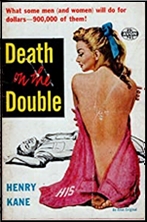
Write the rest yourself. Any decent writer could, and many did it pretty well, but Kane stumbles in his portrait of the central character. Besides being a perfect schlemiel, Oscar is also built like an Adonis but shy with women, proficient with guns and fists, but a confirmed pacifist and a devout coward. The contradictions in character are just too many and too convenient to the story to make it at all convincing.
Death on the Double consists of two novelettes featuring Peter Chambers. The writing in the first, “Watch the Jools,” is agreeably glib, but the plot is something Keeler would have rejected as overly fanciful. Something about a rare gem with a curse on it, a man found drowned in his locked (and quite dry) private office, a costume party where everyone must dress in the costume dictated by an eccentric millionaire, and… well by the time Kane rang in the sword-swallowing Master Criminal, I was ready to call it quits. “Beautiful Day,” the second half of Death on the Double awaited, but I had a Fredric Brown next on the pile….
—
Note: Updated to include information about the TV adaptation of My Darlin’ Evangeline. (See comment #3.)
Thu 7 Jan 2021
REVIEWED BY RAY O’LEARY:
MAXIM JAKUBOWSKI, Editor – The Mammoth Book of Pulp Action. Carroll & Graf, trade paperback, December 2001.
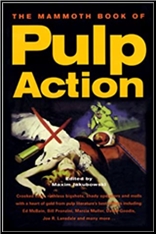
There was only one story, Fredric Brown’s classic “Don’t Look Behind You,” that I’d read before in this solid anthology of what the editor calls Pulp Fiction though not all the stories were published in the pulps. Since there are too many to go through one by one, I will just comment on some of them.
The volume opens with Erle Stanley Gardner’s “The Kid Clips a Coupon,” which features The Patent Leather Kid (a sort of Simon Templar/Raffles type character), who manages to steal $70,000 while clearing an innocent man of murder. Though Gardner wasn’t much of a prose stylist, I find his stories featuring minor series characters like the Kid or Lester Leith compulsively readable.
“Motel†by Evan Hunter seems to be added for the author’s name value since the only action in it is the pounding on the motel room’s walls by the guy in the next room. It’s three chapters depicting the beginning, middle and end of an adulterous relationship, and should be in The Mammoth Book of Adultery if/when that’s published (or maybe Carroll & Graf already has in the five years since this one came out). Judging by the long list of other Mammoth Books listed in the beginning, it’s only a matter of time.
“Burn, Corpse, Burn” by Bruno Fischer, despite its lurid title, is a sad, sentimental supernatural tale about a lonely man who sees the body of a young woman floating in the water while ice fishing. “The Pulp Connection” by Bill Pronzini has his Nameless sleuth solve the murder of a man killed in the locked room containing his pulps. Not only is this a homage to John Dickson Carr but also to Ellery Queen since the victim leaves a “dying message” clue.
“Caravan to Tarim'” by David Goodis is a pretty good Arabian adventure story rather than a crime tale per se. “The First Five in Line” is the opening twenty pages of an unfinished novel by Charles Willeford. Intriguing is the word. “Where There’s a Will, There’s a Slay” by Frederick C. Davis has a man returning to his home town to open a factory, trying to solve the murder of a lawyer friend and. confronting a nest of vipers.
“Dog Life” by Mark Timlin is the only story written for volume. A man avenges the murder of a petty crook/informant though his motive and identity isn’t revealed. Finally, “The Pit” by Joe R. Lansdale is about a small town of redneck types who kidnap any strange men of a certain age who pass through, hold them prisoner while training them and pit them against each other in an unarmed fight to the death.
There are quite a few more stories that are well worth reading in the 630 pages of this fat paperback.
— Reprinted from The Hound of Dr. Johnson #44, March 2006.
Wed 25 Nov 2020
SPACE SCIENCE FICTION. May 1952. (Volume 1, Number 1.) Overall rating: 3 stars.
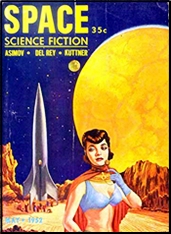
LESTER del REY “Pursuit.†Feature novel. A man with unknown assailants pursued for unknown reasons for the major part of the story finally discovers that it is his own unconscious mind plus an uncontrolled psi factor which has been creating his monsters. The plot, meant to sweep the reader along with the hero’s plight, jumps badly at times, simply because of vague details or incongruous background. Also, forty-two pages is a long time for confusion to run rampant. (1)
Comment: Collected in Gods and Golems (Ballantine, paperback original, 1973). Also of note, perhaps, is that Lester del Rey was also the editor of this magazine.
JERRY SOHL “The Ultroom Error.†A readable but pointless story of a life-germ transplanting process gone wrong. (2)
Comment: Collected in Filet of Sohl: The Classic Scripts and Stories of Jerry Sohl (Bear Manor Media, softcover, 2003). Besides a dozen or so SF novels published later on, Sohl also wrote scripts for Alfred Hitchcock, Twilight Zone, Star Trek and several other TV shows.
ISAAC ASIMOV “Youth.†Novelette. The illustrations give away the ending, obviously meant to be hidden. Two alien cultures meet and initiate friendly relations, but the identity of each cannot be determined from the context. (4)
Comment: Collected in The Martian Way and Other Stories (Doubleday, hardcover, 1955). This is clearly a small gem whose first appearance is hidden away in what is today an sadly obscure magazine.
HENRY KUTTNER “The Ego Machine.†Novelette. A badly confused robot carries on an ecological experiment in adjusting a Hollywood screenwriter’s character to his environment. The wild type of science-fictional comedy that made Kuttner famous. Incidentally, this novelette has only three pages fewer than the feature novel. (5)
Comment: ISFDb suggests that this story was co-written with C. L. Moore. Reprinted in Science-Fiction Carnival, edited by Fredric Brown & Mack Reynolds (Shasta, hardcover, 1953). Collected in Return to Otherness (Ballantine, paperback original, 1962).
BRYCE WALTON “To Each His Own Star.†A predictable story of four men lost in space, each wanting to go his own way. (2)
Comment: Reprinted in Space Odysseys: A New Look at Yesterday’s Futures, edited by Brian W. Aldiss (Doubleday, hardcover, 1976). Collected in “Dark of the Moon” and Other Stories (Armchair Fiction Masters of SF #1, softcover, 2011). Walton was the author of several dozen short stories between 1945 and 1969, but only one novel, one of the Winston series of YA books, which I’m sure explains why he’s a Little Known Author today.
– June 1967
Wed 17 Apr 2019
REVIEWED BY DAN STUMPF:

SCREAMING MIMI. Columbia Pictures, 1958. Anita Ekberg, Philip Carey, Gypsy Rose Lee, Harry Townes, Linda Cherney. Based on the novel The Screaming Mimi, by Fredric Brown. Director: Gerd Oswald.
THE BIRD WITH THE CRYSTAL PLUMAGE. Seda Spettacoli, Italy-Germany, 1970. CBS, US, 1977 (TV, original airing). 21st Century Film Corporation, US, 1982. (theatrical re-release). Original title: L’uccello dalle piume di cristallo. Tony Musante, Suzy Kendall, Enrico Maria Salerno, Eva Renzi. Screenplay by Dario Argento, based on the novel The Screaming Mimi by Fredric Brown (uncredited). Director: Dario Argento.
I’ve spoken often and highly of Fredric Brown;s classic mystery novel of strip-clubs and theology, The Screaming Mimi (Dutton, 1949) and recently betook myself to watching both film versions of it, side-by-side and back-to-back, through the miracle of VCRm watching a chunk of one, then the other, than back again…

The Screaming Mimi (Columbia, 19580 offers some kicking-and-kinky direction from Gerd Oswald, a cult director in the Jim Jones tradition, which is to say he showed a lot of potential in low-budget westerns and thrillers, and managed one classic, A Kiss Before Dying (1956) before drinking the kool-aid of network television.
Mimi belongs to his Promising period, with a pleasantly straightforward (for the 50s) to homosexuality, bondage, obsession and amour fou, but it’s undone by a screenplay that seems way too limp for a movie about serial killings.

There’s never a sense of momentum here, no feeling of progressing towards some resolution. Instead, events just seem to come along and happening no particular order, the head off in any direction whatever, just sort of strutting and fretting across the screen till their allotted hour-or-so is over at last.
A pity, because there are glimmers here and there of what could have been a perverse classic.
The Bird with the Crystal Plumage (Italy, 1970) on the other hand, is a certified wowser. The directorial debut of Dario Argento, who became something of a Name in Horror films, this is a garish, fast-moving, humorous movie about serial slashing, stalking, knifing and general mayhem set against colorful locations, played and/or dubbed by a cast a cut (sorry!) above the usual run of Italian imports.

Fredric Brown got no screen credit for this film, and for years critics who knew nothing about Pulp averred that it was based on an Edgar Wallace story, but I defy anyone out there to show me an Edgar Wallace book with this plot. I’ll wrestle anyone in the crowd who thinks he can do it. No takers? I thought not.
Anyway, getting back to the story, this follows Brown’s novel pretty closely, right down to the minor characters and bits of by-play. Argento tossed away the thematic framework of Brown’s novel, and he turned the hard-drinking loner of the book into a young married couple, ut that’s a fate that befell many of us in the 70s.

The fact is, this is a fairly faithful translation of The Screaming Mimi into film, and if not all of it could have been (The real meaning of the book isn’t revealed until the last page, and it’s truly harrowing.), it’s at least a fun ride.
— Reprinted from
The Hound of Dr. Johnson, May 2005.




